The Pulitzer Prize is American journalism’s most prestigious honor.
We’ve won 59 Pulitzer Prizes, including 36 for photography, since the award was established in 1917 by publisher Joseph Pulitzer to recognize outstanding achievement in journalism.
We’ve won 59 Pulitzer Prizes, including 36 for photography, since the award was established in 1917 by publisher Joseph Pulitzer to recognize outstanding achievement in journalism.
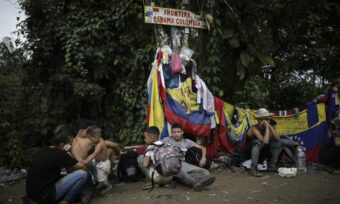
AP won the Pulitzer Prize for Feature Photography for its compelling, multi-country photojournalism showing migration from Central America to the United States. The prize was shared by staff photographers Greg Bull, Eric Gay, Fernando Llano, Marco Ugarte and Eduardo Verdugo, and longtime AP freelance photographers Christian Chavez, Felix Marquez and Ivan Valencia.
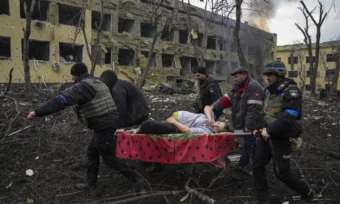
AP won the Pulitzer Prize for Public Service for the work of Mstyslav Chernov, Evgeniy Maloletka, Vasilisa Stepanenko and Lori Hinnant, whose courageous reporting from the besieged city of Mariupol bore witness to the slaughter of civilians in Russia’s invasion of Ukraine; the AP photography staff won for breaking news photography for unique and urgent images from the first weeks of Russia’s invasion of Ukraine.
Emilio Morenatti won for feature photography for a poignant series of photographs that takes viewers into the lives of the elderly in Spain struggling during the COVID-19 pandemic; The AP photography staff won for breaking news photography for a collection of photographs from multiple U.S. cities that cohesively captures the country’s response to the death of George Floyd.
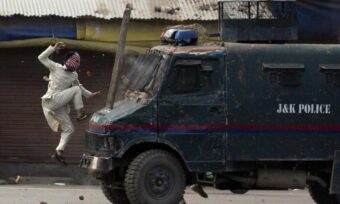
Dar Yasin, Mukhtar Khan and Channi Anand won for feature photography for their gripping photos of life in Indian-controlled Kashmir.
A masked Kashmiri protester jumps over an armored Indian police vehicle as he throw stones at it during a protest in Srinagar, Indian controlled Kashmir, May 31, 2019. (AP Photo/Dar Yasin)
Maggie Michael, Nariman El-Mofty and Maad al-Zikry won for international reporting for their compelling coverage of the conflict in Yemen and the ensuing humanitarian crisis, including a series of deep investigative stories, photos and videos chronicling atrocities spawned by the war.
AP won the Pulitzer Prize for public service for its international investigation of the fishing industry in Southeast Asia that freed more than 2,000 slaves and traced the seafood they caught to supermarkets and pet food providers across the U.S. The investigative reporting was led by Esther Htusan, Robin McDowell, Margie Mason and Martha Mendoza.
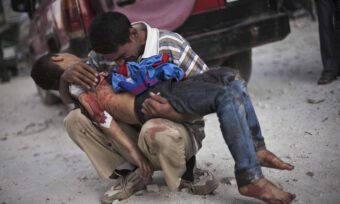
Rodrigo Abd, Manu Brabo, Narciso Contreras, Khalil Hamra and Muhammed Muheisen won for breaking news photography, as seen in gripping images of the Syrian civil war.
A Syrian man cries while holding the body of his son, killed by the Syrian Army, near Dar El Shifa hospital in Aleppo, Syria, Wednesday, Oct. 3, 2012. (AP Photo/Manu Brabo)
Matt Apuzzo, Adam Goldman, Chris Hawley and Eileen Sullivan won the 2012 Pulitzer Prize for investigative reporting for their monthslong series outlining the New York Police Department’s surveillance of minority communities since the 9/11 terror attacks. Read more about the series.
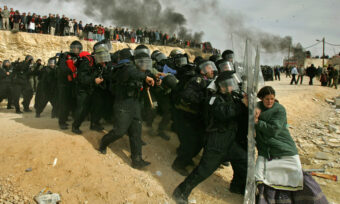
Oded Balilty won for breaking news photography, for his photo showing a Jewish settler struggling with an Israeli security officer during a clash that erupted as authorities evacuated the West Bank settlement outpost of Amona.
A lone Jewish settler challenges Israeli security officers during clashes that erupted as authorities cleared the West Bank settlement of Amona, east of the Palestinian town of Ramallah, Feb. 1, 2006. Thousands of troops in riot gear and on horseback clashed with hundreds of stone-throwing Jewish settlers holed up in this illegal West Bank outpost after Israel’s Supreme Court cleared the way for demolition of nine homes at the site. (AP Photo/Oded Balilty)
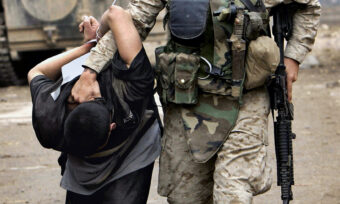
Bilal Hussein, Karim Kadim, Brennan Linsley, Jim MacMillan, Samir Mizban, Khalid Mohammed, John B. Moore, Muhammad Muheisen, Anja Niedringhaus, Murad Sezer and Mohammed Uraibi won for breaking news photography, for a stunning photo series on a year of bloody combat inside Iraqi cities.
A U.S. Marine leads away a captured Iraqi man in the center of Fallujah, Iraq, Nov. 12, 2004. (AP Photo/Anja Niedringhaus)
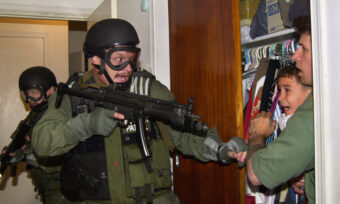
Alan Diaz won for breaking news photography, for his photo of a federal agent in riot gear during a predawn raid in Miami, confronting a man holding Elian Gonzalez in a closet.
Armed federal agents enter the bedroom of a home in Miami’s Little Havana on April 22, 2000, as 6-year-old Elian Gonzalez is held in a closet by Donato Dalrymple, one of the two men who rescued the boy from the ocean months earlier. The agents took custody of Elian at the home of his Miami relatives, eventually repatriating him to Cuba with his father. (AP Photo/Alan Diaz)
Sang-Hun Choe, Charles J. Hanley, Martha Mendoza and Randy Herschaft, won for investigative reporting, for “The Bridge at No Gun Ri,” a package of stories reporting the mass killings of South Korean civilians by American troops at the start of the Korean War.

J. Scott Applewhite, Roberto Borea, Khue Bui, Robert F. Bukaty, Ruth Fremson, Greg Gibson, Ron Heflin, Charles Krupa, Wilfredo Lee, Dan Loh, Joe Marquette, Pablo Martinez Monsivais, Doug Mills, Stephan Savoia and Susan Walsh won for feature photography for a series of pictures of the events surrounding President Clinton’s impeachment; Sayyid Azim, Jean-Marc Bouju, Dave Caulkin, Brennan Linsley, John McConnico and Khalil Senosi won for spot news photography for a series of pictures after the U.S. Embassy bombings in Kenya and Tanzania.
President Clinton walks to the podium in the White House Rose Garden to make a statement on the House impeachment inquiry on Dec. 11, 1998. The president apologized to the country for his conduct and offered to accept congressional censure. (AP Photo/J. Scott Applewhite)
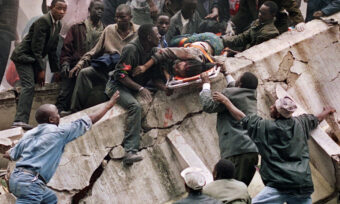
Rescue workers carry Susan Francisca Murianki, a U.S. Embassy office worker, from the rubble of a collapsed building in next to the embassy in Nairobi on Aug. 7, 1998 after terrorist bombs exploded minutes apart outside the U.S. embassies in the Kenyan and Tanzanian capitals. In Nairobi alone more than 200 people were killed and about 4,000 wounded. (AP Photo/Khalil Senosi)
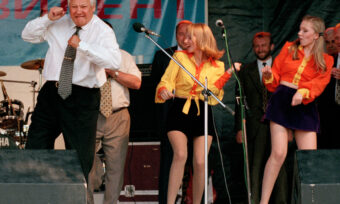
Alexander Zemlianichenko won for feature photography, for his photo of Russian President Boris Yeltsin dancing at a rock concert in Rostov before elections.
Russian President Boris Yeltsin dances at a rock concert during a campaign appearance in Rostov, June 10, 1996. Yeltsin went on to defeat Communist challenger Gennady Zyuganov in a runoff election for the Russian presidency. (AP Photo/Alexander Zemlianichenko)
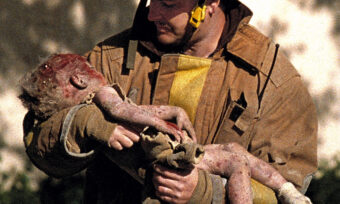
Charles Porter IV won for spot news photography, for his photo of a fireman cradling an infant victim of the Oklahoma City bombing.
Oklahoma City fire Capt. Chris Fields carries 1-year-old Baylee Almon, injured in the April, 19, 1995 bombing of the Alfred Murrah Federal Building in downtown Oklahoma City. The child died of her injuries. (Charles H. Porter IV via AP)
Mark Fritz won for international reporting, for reports on the ethnic violence in Rwanda.
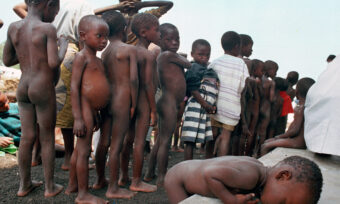
Javier Bauluz, Jean-Marc Bouju, Jacqueline Arzt Larma and Karsten Thielker won for feature photography, for photos of the ethnic violence in Rwanda.
A Rwandan child, too weak from malnutrition to stand in line for vaccination, rests his head on a ledge at a crowded refugee camp for orphaned children in Ndosho, Zaire, July 28, 1994. (AP Photo/Jacqueline Arzt Larma)
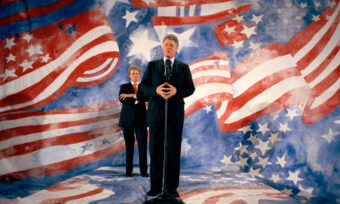
J. Scott Applewhite, Richard Drew, Greg Gibson, David Longstreath, Doug Mills, Marcia Nighswander, Amy Sancetta, Stephan Savoia, Reed Saxon and Lynne Sladky won for feature photography, for a series of pictures from the 1992 U.S. presidential campaign.
Democratic presidential hopeful Bill Clinton addresses the media as U.S. Rep. Joseph Kennedy, D-Mass., joins him at a Boston campaign stop the evening of April 28, 1992, the night of the Pennsylvania primary. Clinton’s convincing win in the Keystone State had reinforced his primary lead over former Gov. Jerry Brown. (AP Photo/Stephan Savoia)
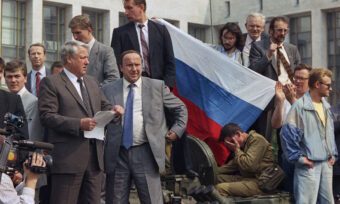
Olga Shalygin, Liu Heung Shing, Czarek Sokolowski, Boris Yurchenko and Alexander Zemlianichenko won for spot news photography, for a series of pictures on the attempted coup in the Soviet Union and the collapse of the Communist regime.
Boris Yeltsin, president of the Russian Federation, makes a speech from atop a tank in front of the Russian parliament building in Moscow, U.S.S.R., Monday, Aug. 19, 1991. Yeltsin called on the Russian people to resist the communist hard-liners in the Soviet coup. (AP Photo)
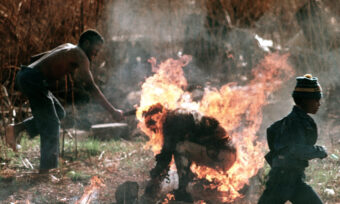
Greg Marinovich won for spot news photography, for a series of pictures showing the brutal killing of a man believed to be a Zulu Inkatha supporter in South Africa.
A man hacks at Lindsay Tshabalala, a Zulu beaten and burned to death as a suspected Inkatha faction member by African National Congress supporters in Soweto, South Africa, Sept. 15, 1990. More than 3,000 people died in 1990 as a result of ANC-Inkatha violence that was provoked by a state-sponsored destabilization program prior to South Africa’s first democratic elections in 1994. Elements of the South African government, in a shadow alliance with Zulu Inkatha and security forces, promoted violence against the ANC in the black townships. (AP Photo/Greg Marinovich)

Bill Foley won for spot news photography, for a series of pictures of victims and survivors of the massacre of Palestinians in a refugee camp in Beirut.
A Palestinian woman brandishes helmets during a memorial service in Beirut Sept. 27, 1982, for victims of Lebanon’s Sabra refugee camp massacre. She claimed the helmets ere worn by those who massacred hundreds of her countrymen. (AP Photo/Bill Foley)
Saul Pett won for feature writing, for a series of stories on the bureaucracy of the federal government.
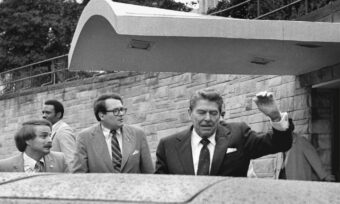
Ron Edmonds won for spot news photography, for a series of pictures showing the attempted assassination of President Reagan.
In these three March 30, 1981 black-and-white photos, President Reagan waves, then looks up before being shoved into Presidential limousine by Secret Service agents after being shot outside a hotel in Washington. (AP Photo/Ron Edmonds)
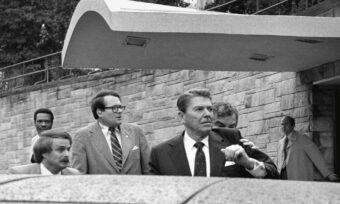
In these three March 30, 1981 black-and-white photos, President Reagan waves, then looks up before being shoved into Presidential limousine by Secret Service agents after being shot outside a hotel in Washington. (AP Photo/Ron Edmonds)
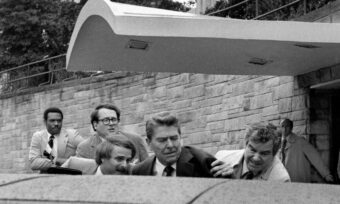
In these three March 30, 1981 black-and-white photos, President Reagan waves, then looks up before being shoved into Presidential limousine by Secret Service agents after being shot outside a hotel in Washington. (AP Photo/Ron Edmonds)
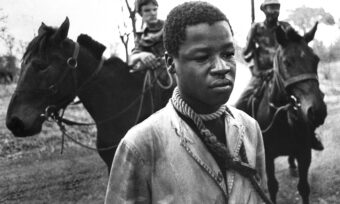
J. Ross Baughman won for feature photography, for a series of pictures showing white Rhodesian soldiers beating and torturing black nationalist guerrillas.
A Rhodesian prisoner stands with a rope tied around his neck to prevent escape, placed there by Rhodesian cavalrymen, background, who detained him for questioning in Lupane, southern Rhodesia, in September 1977. Rhodesia’s white-dominated government was countering black guerrilla activities with militant armed forces. (AP Photo/J. Ross Baughman)

Neal Ulevich won for spot news photography, for a series of pictures showing bloody fighting between police and left-wing students in Bangkok, Thailand.
A right-wing supporter strikes the lifeless body of a hanged student outside Thammasat University in Bangkok, Oct. 6, 1976. Police stormed the university after students demanded expulsion of a former military ruler and barricaded themselves in the school. (AP Photo/Neal Ulevich)
Walter R. Mears won for national reporting, for reports on the 1976 presidential campaign and election.
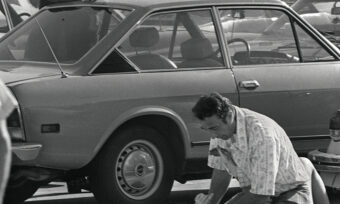
Anthony K. Roberts won for spot news photography, for his picture sequence made during an alleged kidnapping attempt in Hollywood.
George H. Derby, left, a security guard, aims his gun at Edward F. Fisher, 39, who holds a knife to the throat of Ellen Sheldon, 22, during a kidnapping attempt in a Hollywood parking lot, Nov. 23, 1973. Sheldon managed to struggle to her feet, and seconds later Derby fired once after warning the suspect repeatedly. Fisher was killed instantly; Sheldon sustained minor injuries. (Anthony K. Roberts via AP)
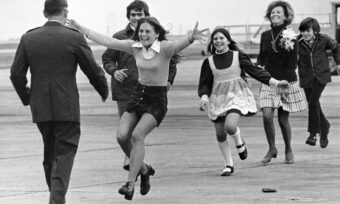
Slava (Sal) Veder won for feature photography, for a picture of a U.S. Air Force officer being greeted by his family after being held a prisoner of war in Vietnam.
Released prisoner of war Lt. Col. Robert L. Stirm is greeted by his family at Travis Air Force Base in Fairfield, Calif., as he returns home from the Vietnam War, March 17, 1973. Leading is Stirm’s daughter Lori, 15, followed by son Robert, 14; daughter Cynthia, 11; wife Loretta and son Roger, 12. Stirm was held more than five years after his plane was shot down over North Vietnam in 1968. (AP Photo/Sal Veder)

Huynh Cong (Nick) Ut won for spot news photography, for a picture of a Vietnamese girl fleeing in terror after a napalm attack.
South Vietnamese forces follow after terrified children, including 9-year-old Kim Phuc, center, as they run down Route 1 near Trang Bang after an aerial napalm attack against suspected Viet Cong hiding places on June 8, 1972. Kim Phuc had ripped off her burning clothes after a South Vietnamese plane mistakenly dropped its incendiary bombs on South Vietnamese troops and civilians. The young girl is accompanied by her injured brothers and cousins; behind them are Vietnamese soldiers of the 25th Division. (AP Photo/Nick Ut)

Horst Faas and Michel Laurent won for spot news photography, for a series of pictures of tortures and executions in Bangladesh.
In newly independent Bangladesh, soldiers in Dacca use bayonets to torture and kill four men suspected of collaborating with Pakistani militiamen during months of civil war. (AP Photo/Horst Faas, Michel Laurent)

Steve Starr won for spot news photography, for a picture of armed black students emerging after their 36-hour occupation of a Cornell University building.
Armed students led by Ed Whitfield, far right, leave Straight Hall at Cornell University in Ithaca, N.Y., after a 36-hour sit-in, April 20, 1969. The students had barricaded themselves in the building demanding a degree-granting African American studies program. University administrators offered to drop some charges against the students and accelerate the opening of an African American studies center. (AP Photo/Steve Starr)

Edward (Eddie) Adams won for spot news photography, for a picture of Vietnamese Brig. Gen. Nguyen Ngoc Loan executing a Viet Cong prisoner on a Saigon street.
South Vietnamese Gen. Nguyen Ngoc Loan, chief of the national police, fires his pistol into the head of suspected Viet Cong officer Nguyen Van Lem (also known as Bay Lop) on a Saigon street Feb. 1, 1968, early in the Tet Offensive. The general said Nguyen Van Lem was responsible for numerous Vietnamese and American deaths. (AP Photo/Eddie Adams)
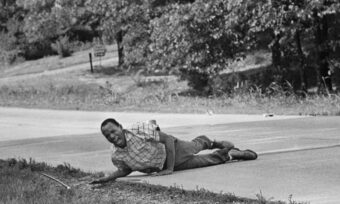
Jack Thornell won for photography, for a picture of James Meredith falling after being hit by a shotgun blast near Hernando, Miss.
Civil rights activist James Meredith grimaces in pain as he pulls himself across Highway 51 after being shot in Hernando, Miss., June 6, 1966. Meredith was leading the March Against Fear to encourage African Americans to exercise their voting rights when he was shot. He completed the march from Memphis, Tenn., to Jackson, Miss., after treatment of his wounds. (AP Photo/Jack Thornell)
Peter Arnett won for international reporting, for war reports from Vietnam.
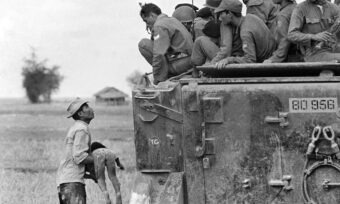
Horst Faas won for photography, for photos from Vietnam.
A father holds the body of his child as South Vietnamese Army Rangers look down from their armored vehicle March 19, 1964. The child was killed as government forces pursued guerrillas into a village near the Cambodian border. (AP Photo/Horst Faas)
Malcolm Browne won for international reporting, for war reports from Vietnam, including the overthrow of the Diem regime.

Paul Vathis won for photography, for a picture of President Kennedy and former President Eisenhower walking at Camp David following an unsuccessful 1961 Cuban invasion.
With their heads bowed, President John F. Kennedy, left, walks along a path at Camp David near Thurmont, Md., with former President Dwight D. Eisenhower, April 22, 1961, as the two met to discuss the Bay of Pigs invasion. The photo was shot between the legs of a Secret Service agent. (AP Photo/Paul Vathis)
Lynn Heinzerling won for international reporting, for reports on the early stages of the Congo crisis and analysis of other African events.
Relman Morin won for national reporting, for reports on school desegregation rioting at Little Rock.

Virginia Schau won for photography, for a photo of a thrilling rescue in Redding, California.
Paul Overby, one of two drivers trapped in the cab of a tractor trailer, is pulled to safety by a rope on the Pit River Bridge across Shasta Lake near Redding, Calif., May 3, 1953. Both Overby and co-driver Hank Baum were rescued before the cab burned and fell to the rocks below. Virginia Schau, an amateur photographer, used a Kodak Brownie camera to shoot the photo. (Virginia Schau via AP)
Don Whitehead won for national reporting, for a story on President-elect Eisenhower’s secret trips to Korea.
John Hightower won for international reporting, for reporting of international affairs.

Max Desfor won for photography, for a picture of Korean War refugees in flight over ruins of a Taedong River bridge.
In bitter cold, residents from Pyongyang, North Korea, and refugees of other areas crawl over precarious, tangled girders of a bridge across the Taedong River on Dec. 4, 1950, as they flee south ahead of advancing Chinese Communist troops fighting on the side of North Korea. (AP Photo/Max Desfor)
Relman Morin and Don Whitehead won for international reporting, for war reports from Korea.
Eddy Gilmore won for telegraphic reporting (international), for news reports from Russia, especially an interview with Josef Stalin.

Arnold Hardy won for photography, for his photo of a girl leaping from a hotel fire.
A woman plunges from the upper floors of Atlanta’s Winecoff Hotel as a fire traps many occupants, Dec. 7, 1946. The woman was reported to have survived after her fall was broken by part of the hotel marquee. The fire killed 119 people, including he hotel’s owners. (Arnold Hardy via AP)
Hal Boyle won for correspondence, for columns and stories from the North African and European war theaters.

Joe Rosenthal won for photography, for a picture of Marines raising the U.S. flag on Iwo Jima.
U.S. Marines raise a second, larger American flag atop Mt. Suribachi on the Japanese Island of Iwo Jima, Feb. 23, 1945. Three of the men in the photo were later killed in fighting on the island. This is the only photo to win the Pulitzer Prize in the year it was shot. (AP Photo/Joe Rosenthal)
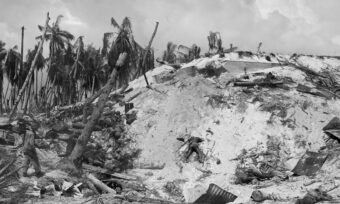
Frank Filan won for photography, for a photo of a destroyed Japanese bunker on the central Pacific atoll of Tarawa.
Dead Japanese soldiers lay scattered around a blasted Japanese pillbox on Tarawa Atoll in the Gilbert Islands of the South Pacific on Nov. 11, 1943 during World War II. (AP Photo/Frank Filan)
Daniel De Luce won for telegraphic reporting (international), for stories on the partisan resistance against the Nazis in Yugoslavia.
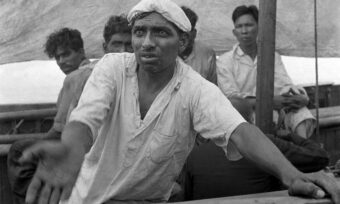
Frank Noel won for photography, for a photo of a survivor of a torpedoed ship begging for water from his lifeboat.
An Indian sailor pleads for water from a lifeboat adrift on the Indian Ocean in January 1942. AP photographer Frank “Pappy” Noel shot this photo from his own lifeboat after a Japanese torpedo sank a ship carrying Noel and others from Singapore. Noel and his fellow survivors eventually reached Sumatra. (AP Photo/Frank Noel)
Larry Allen won for telegraphic reporting (international), for stories on the activities of the British Mediterranean Fleet and on the bombing of the British aircraft carrier Illustrious.
Louis Lochner won for correspondence, for news reports from Nazi Germany.
Howard Blakeslee and four other science writers won for reporting on the Harvard Tercentenary Celebration.
Francis Jamieson won for reporting, for coverage of news of the kidnapping of the infant son of Charles Lindbergh.
Kirke L. Simpson won for reporting, for a series of stories on the burial of “The Unknown Soldier.”
This page is not available in your selected language. You are now viewing the English version.